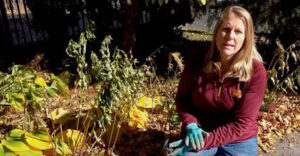Plants for a Butterfly Garden in Minnesota
“Butterflies are not insects… they are self-propelled flowers.”
– Robert Heinlein
When planning for a butterfly-filled garden, we typically choose plants for two purposes: nectar flowers that provide food for butterflies, and host plants that butterflies will lay their eggs on and that the caterpillars will eat.
We can also separate nectar flowers into annuals that won’t survive a Minnesota winter, but often bloom steadily all summer — and perennials that will survive the winter to bloom year after year, but often for only a few weeks or a couple months. It’s important to try to have nectar flowers in bloom all summer long.
Annual Nectar Flowers
| Flower | Bloom Time | Notes |
|---|---|---|
| Cosmos | All summer & fall | |
| Gomphrena | All summer & fall | |
| Latana | All summer & fall | |
| Marigolds | All summer & fall | Deer and rabbit resistant; look for the small French or little gem marigold, Tagetes patula |
| Nicotiana / flowering tobacco | All summer & fall | |
| Pentas | All summer & fall | |
| Sunflowers | Mid summer through fall | Look for branching varieties with many smaller flowers |
| Tithonia / Mexican sunflower | Late summer & fall | |
| Zinnia | All summer & fall | Deer and rabbit resistant |
Tip: Some modern cultivars of flowers don’t actually provide any nectar — it’s been bred out of them in exchange for showier flowers. Native varieties are always great, but most varieties of flowers on this list will be good. Avoid plants with elaborate double flowers.
Perennial Nectar Flowers
| Flower | Bloom Time | Notes |
|---|---|---|
| Allium | Spring | Deer & rabbit resistant |
| Chives | Spring | Deer & rabbit resistant |
| Columbine | Spring | Look for the native red & yellow Aquilegia canadensis |
| Bee balm | Summer | Deer & rabbit resistant |
| Wild bergamot | Summer | Deer & rabbit resistant |
| Butterfly weed | Summer | Deer & rabbit resistant |
| Coreopsis | Summer | |
| Dasies | Summer | |
| Echinacea / purple cone flower | Summer | |
| Gaillardia / blanket flower | Summer | |
| Joe-pye weed | Summer | Deer & rabbit resistant |
| Lavender | Summer | Deer & rabbit resistant |
| Liatris / blazing star | Summer | |
| Rattlesnake master | Summer | Deer & rabbit resistant |
| Rudbeckia / black-eyed susan | Summer | |
| Yarrow | Summer | Deer & rabbit resistant |
| Asters | Fall | |
| Chrysanthemums | Fall | |
| Goldenrod | Fall | Deer & rabbit resistant; not an allergen |
| Sedum | Fall |
Butterfly Host Plants
| Plant | Hardiness | Butterfly | Notes |
|---|---|---|---|
| Dill | Annual | Black swallowtail | Herb |
| Rattlesnake master | Perennial | Black swallowtail | Deer and rabbit resistant |
| Snapdragon | Annual | Buckeye | |
| Clover | Perennial | Common sulphur | Favored by rabbits & deer |
| Violets | Perennial | Great spangled fritillary | Look for the native perennial |
| Milkweed | Perennial | Monarch | Deer & rabbit resistant. Many varieties. Common milkweed can be too aggressive for small gardens |
| Butterfly weed | Perennial | Monarch | Milkweed variety that is most garden friendly and most commonly sold at garden stores |
Host Plant Notes
Plant host plants in large clumps to help the butterflies find them.
Not all butterflies will need a host plant in your garden. Butterflies like the Tiger Swallowtail and Viceroy caterpillars feed on leaves of trees, and others feed on rotting fruit and even dung.
Remember, if your host plants are doing their job they will get eaten! Holes in leaves and raggedy plants are a sign of success.
–By Brian Wood, Master Gardener Volunteer

